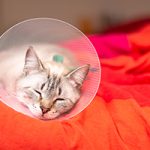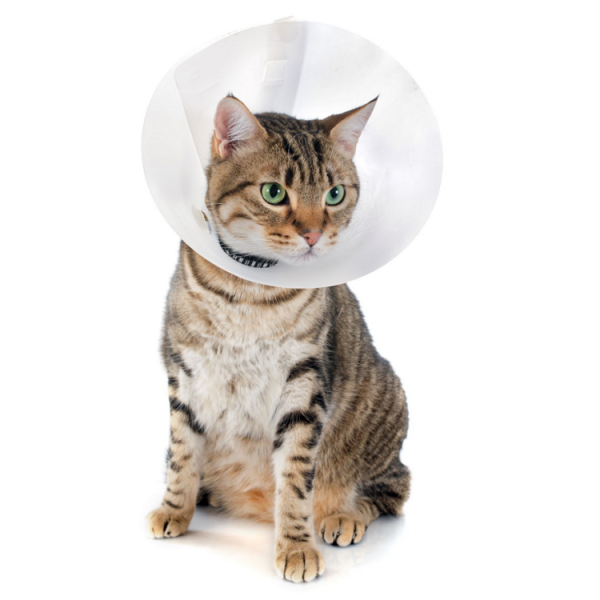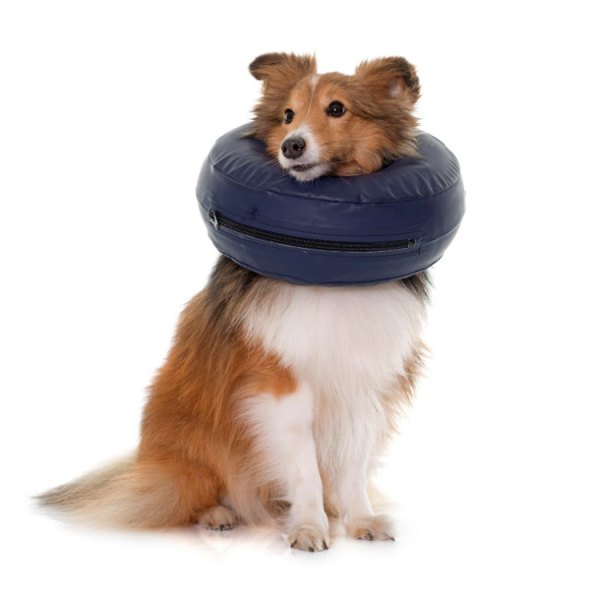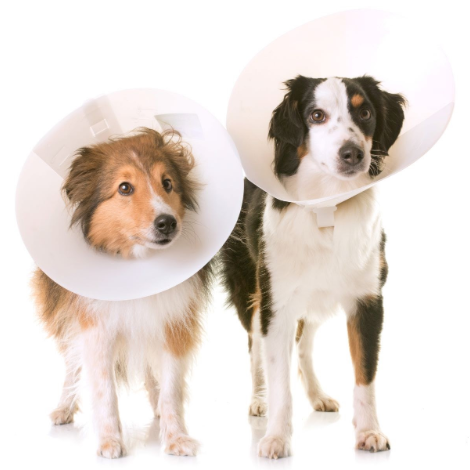
My veterinarian prescribed a collar for my pet
Your dog or cat has undergone surgery or has skin disorders and the veterinarian has put a collar on it ? You wonder how he will be able to bear, for the full recommended duration, this accessory that makes him so clumsy and you are already thinking of removing it ? Attention, wearing this straitjacket makes, as well as the medication or care that may have been prescribed, integral part of his treatment !

The collar is a device intended to prevent a cat or dog from licking or scratching itself., usually time to let a wound heal. It is a system that, although often misunderstood, remains very useful because it is quite impossible for an animal that feels itchy to refrain from scratching or licking itself...
Different types of bezels
Different types of devices exist
The most common is the classic collar also called yoke : it is a transparent or translucent plastic cone with an opening to pass the head. There are different sizes and their diameter is adjustable to best adapt to the size of the animal's neck.. Tabs at the base of the yoke allow you to pass a link or collar through it to keep it in place. The head is thus surrounded, preventing the animal from licking its body or scratching its face, while leaving him the possibility of drinking or eating.
There is also another type of collar : the inflatable collar or moon collar. It is a kind of necklace to put around the neck and which, once inflated, prevents rolling over and licking the body. However, this model does not always necessarily prevent the animal from scratching or rubbing its head on the ground or against the corners of furniture... The rigid cone is therefore more appropriate for localized lesions on the head..
The use of a particular type of collar therefore depends on the location of the wound to be protected..

Indications
In a general way, the collar is intended to prevent access to a wound or dressing. This lesion may concern the head (the collar will then limit any rubbing or scratching of the area concerned) or another area of the body (the yoke then preventing any licking or biting of the lesion). An animal that feels itchy or in pain will, Indeed, naturally seek relief by licking or scratching without worrying that it might be harmful. Or, these actions can hinder or even prevent healing : contrary to popular belief, saliva from a dog or cat has no antiseptic properties, on the contrary ! Saliva is a medium in which live many bacteria that can cause superinfection of a wound.
A straightjacket will generally be prescribed
- Following surgery : Following an operation, the animal may feel pain or itching. If he can access the surgical wound, he risks tearing his stitches. The yoke will prevent any access to the operated area. Similarly, when the location of the surgery makes it very difficult to apply a dressing, preventing it from holding in place, or that the intervention performed requires leaving the wound in the open air, the collar is essential.
- In case of injury : the presence of a bite wound, for example, an abscess or any other type of injury is often a source of pruritus. To allow proper healing, collar may be necessary.
- In case of skin problem : certain conditions such as skin allergies (allergy to flea bites for example), various parasitic dermatoses or otitis often cause intense itching responsible for the appearance of secondary scratching wounds or even superinfection.
Manual
If your dog or cat usually already wears a collar, the best is to fix the collar on this collar. Otherwise, a fairly wide fabric tie can be used to secure the collar to the animal's neck. It is better to avoid too thin strings and threads which could shear the skin.
Care must be taken to adjust the link or collar ideally : it should not be too tight (you must be able to fit at least two fingers between the animal's neck and the collar or tie), nor too loose (check that the tie is tight enough so that the collar cannot pass too easily around the cat's or dog's head, a sign that he could take it off too easily).
The best, once the collar is installed, is not to touch it anymore. Its size and shape are adapted so that the animal can continue to eat and drink normally.

Disadvantages and precautions
The collar is a very useful accessory but also often difficult for the animal to bear at first.. It often happens that the animal starts to walk backwards just after the yoke is put on !
Its port modifies, Indeed, apprehension of the environment, in particular the field of vision and the reception of sounds. The identification of obstacles is disturbed, the animal may bump into furniture or walls. Eating and drinking also becomes more complicated…
However, you have to be patient. The animal generally ends up getting used to the presence of the collar after 1 or 2 days. He will adapt all the better to wearing this straitjacket if he wears it all the time.. If you give in and take it away from him, you might not be able to give it to him and especially, if it escapes your vigilance for a short time, he may lick himself or tear his sutures (a few seconds are enough !)
If it's hard to do, create a diversion by playing with him, by drawing his attention to a toy or suggesting various activities. To make it easier for him to take food and drink, you can replace his usual bowl with a container better suited to taking food with a yoke. Raising his bowl can also help him. About the cats, if your cat has a litter box closed by a lid, it is better to remove the cover for a few days and leave only the tray which will be much easier to use alone while wearing the collar. Better to temporarily deny him access to the outside. The apprehension of the external environment with the collar is complicated and you will not be, In addition, not there to watch over him and help him if needed.
You would have understood it, wearing the collar is a necessary evil for your pet to heal and it is essential not to remove it. Although it is rare, it may happen that some animals do not get used to wearing the collar at all and that they remain completely prostrate, even a few days ago. In this case, do not hesitate to contact your veterinarian to ask him for advice and find a solution with him.
Author : Dr. Helen Blondel. Illustrator : Dr. Caroline Allard – Vetup®
